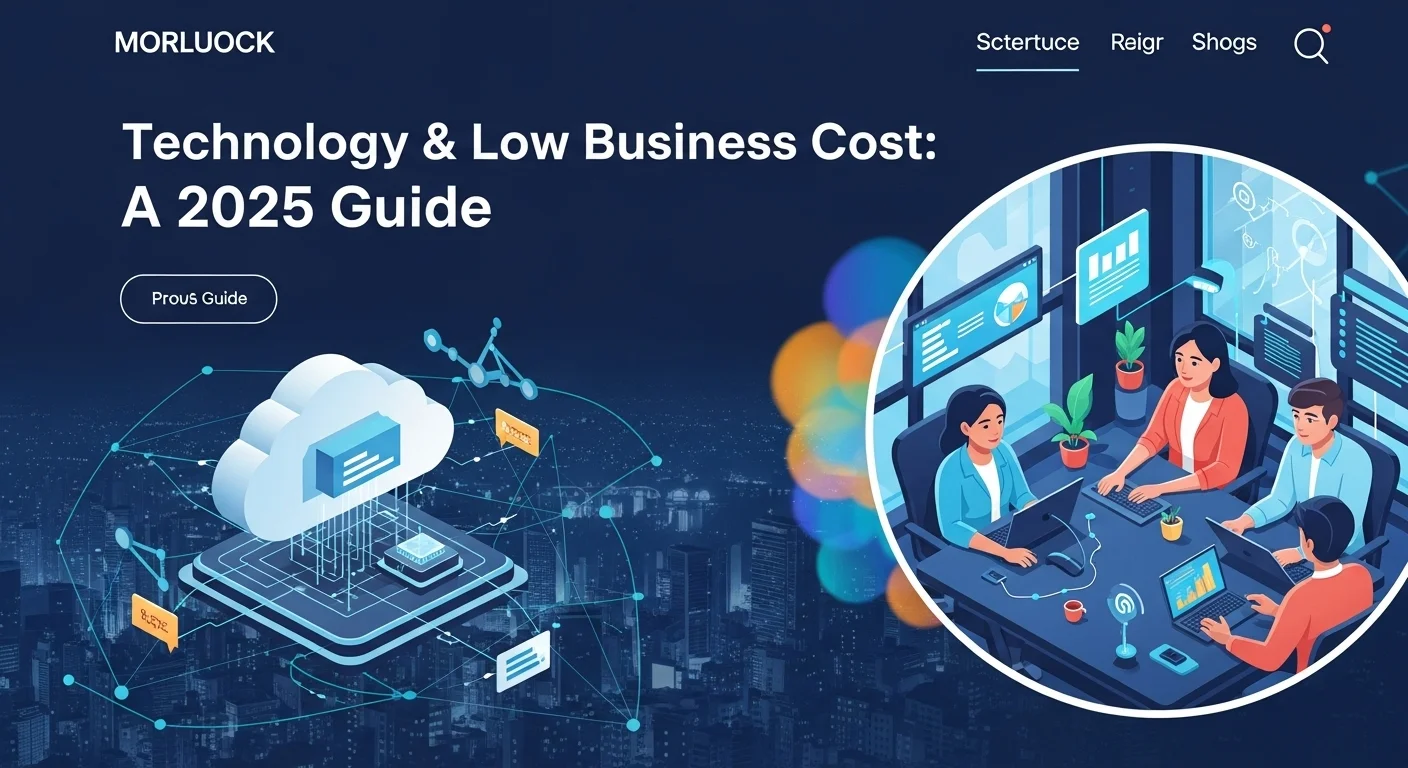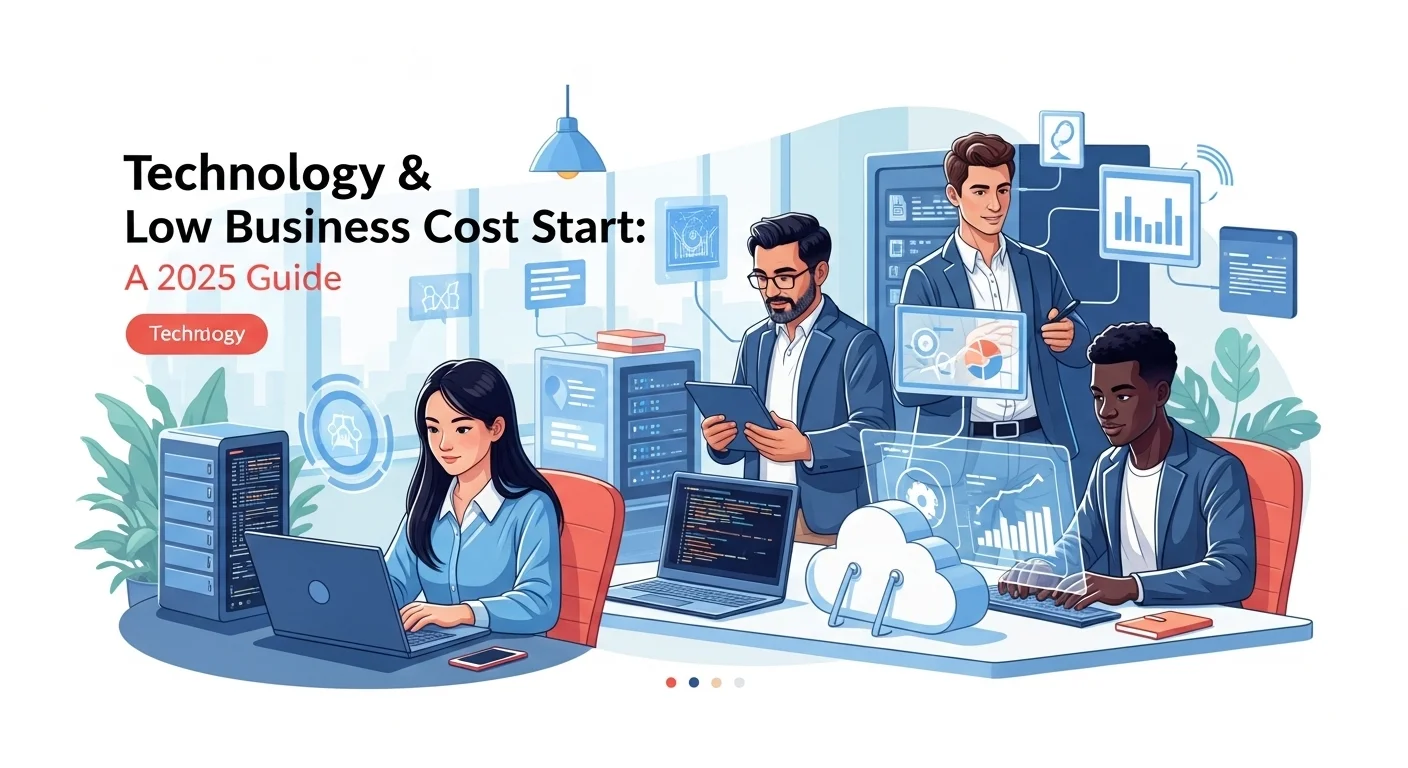Launch Your Dream Business on a Budget: The 2025 Tech Guide

Executive Summary
I remember a time when launching a business meant securing hefty bank loans and renting expensive office space. Honestly, those days feel like ancient history. Today, technology has completely changed the game, making it possible for anyone with a great idea to build and scale a business with very little starting cash. This isn't about being 'cheap'; it's about being smart and resourceful. Thanks to breakthroughs in cloud computing, AI, and a world of free software, the barriers that once stood in the way have crumbled. These tools let you automate tasks, cut down on overhead, and reach customers around the globe from your kitchen table. This article is my personal take on this amazing relationship between tech and lean entrepreneurship. We'll dive into the specific tools and strategies I've seen work time and again, from free cloud services to affordable cybersecurity. For anyone dreaming of starting their own thing, understanding how to use these technologies isn't just a nice-to-have—it's the foundation for building a competitive and resilient business in today's digital world.
Table of Contents
Table of Contents
- What Does 'Low-Cost Start' Really Mean?
- Why Technology is the Secret Sauce for Lean Startups
- The Key Tech Pillars That Make It All Possible
- Looking Ahead: The Future of Lean Businesses in 2025
What Does 'Low-Cost Start' Really Mean?
When I talk about a 'Low-Cost Start,' I'm not talking about cutting corners or sacrificing quality. It’s a mindset. It's about launching a business with minimal financial investment by being incredibly resourceful. In the past, starting up was all about capital—you needed money for an office, inventory, a big staff, and flashy marketing. The digital revolution blew that model apart. Now, a successful launch is about being capital-efficient, using technology to do the heavy lifting that once required a huge budget. This shift has been a game-changer, opening the doors for innovators from all walks of life to test their ideas in the real world. In my experience, some of the most successful companies today started as lean ventures—often with just a laptop and a brilliant idea.
Why Technology is the Secret Sauce for Lean Startups
The tech world is a fascinating place because it both enables and thrives on the low-cost startup model. On one hand, technology provides the tools to start lean. On the other, the tech industry itself is the perfect playground for these kinds of ventures. The connection is powerful and self-reinforcing. It democratizes entrepreneurship, proving that a great idea doesn't need to be backed by a trust fund or venture capital. This is especially true for anyone wanting to start a business from home, turning a personal passion into a livelihood that contributes to the economy. These lean businesses are also incredibly agile. They can pivot based on customer feedback almost instantly, which is a massive advantage over larger, slower corporations.
The Key Tech Pillars That Make It All Possible
So, what are these magical tools? They generally fall into a few key categories that have completely reshaped the startup landscape:
- Cloud Computing: This is probably the biggest factor. Services like Amazon Web Services (AWS), Google Cloud, and Microsoft Azure have made expensive physical servers obsolete. You can now tap into massive computing power and storage on a pay-as-you-go basis. Many even offer generous 'free tiers' that are perfect for getting off the ground. For a lean startup, this erases one of the biggest initial costs.
- Open-Source Software: The spirit of collaboration has given us a treasure trove of high-quality, free software. From operating systems like Linux to the WordPress platform that powers a huge chunk of the internet, open-source tools provide a rock-solid foundation for countless businesses without the sting of expensive license fees.
- Software as a Service (SaaS): This model is a dream for bootstrappers. For a low monthly fee, you get access to powerful tools for everything from customer management (CRM) and accounting to marketing. It replaces the need for huge upfront software purchases and gives you predictable monthly expenses.
- Digital Marketing & Social Media: Forget massive ad budgets for TV or print. Today, you can reach a highly specific, global audience through platforms like Google, Instagram, and LinkedIn. With a smart strategy combining SEO and content marketing, you can build a following for a fraction of the traditional cost.
Looking Ahead: The Future of Lean Businesses in 2025
As we look toward 2025, technology's role is only getting bigger. Artificial Intelligence (AI) is becoming more accessible and sophisticated, acting as a force multiplier for small teams. AI can now help with everything from writing marketing copy and handling customer service with chatbots to analyzing complex data. Imagine an e-commerce startup using AI to give personalized product recommendations—a feature once reserved for giants like Amazon. Plus, the rise of 'no-code' and 'low-code' platforms is empowering people who aren't developers to build their own apps and websites. This continuous innovation means the future of entrepreneurship will be defined less by your bank balance and more by your vision and ability to cleverly use technology. For instance, a freelance designer can build a global business with a simple portfolio site, find clients on Upwork, manage projects with Trello, and handle invoices with Wave—all for less than the cost of a nice dinner out. This is the new reality: your primary investment is your time, skill, and strategy, not your capital.

Your Complete Guide to a Low-Cost Launch with Tech Solutions
Starting a business on a tight budget isn't about luck; it's about having the right playbook. Here’s a straightforward guide to the tech and strategies that I've seen help entrepreneurs succeed without breaking the bank. By using these resources smartly, you can keep your costs down while setting yourself up for real growth. Honestly, there's never been a better time to launch a lean business.
Your Tech Toolkit for a Shoestring Budget
Your technology stack is the backbone of your modern, low-cost venture. Getting this right from day one can save you a fortune in both money and time. My advice? Always prioritize tools that are efficient, scalable, and won't drain your wallet.
1. Cloud Computing: Your Business's Digital Home
For any lean startup, the cloud is non-negotiable. It means you don't have to buy or manage any physical servers. It's a game-changer. Here’s what you need to know:
- Infrastructure as a Service (IaaS): Think of this as renting the raw computing power. Services like AWS, Google Cloud, and Azure offer free starter packs that are often more than enough to get your idea launched.
- Platform as a Service (PaaS): This gives you a ready-made environment to build and run your apps without worrying about the technical backend. It's a huge time-saver.
- Software as a Service (SaaS): This will be your daily go-to. Instead of buying software, you subscribe. My essential starter pack includes:
- CRM: HubSpot CRM has a fantastic free version to start managing customer relationships from day one. It's a habit you want to build early.
- Project Management: Tools like Trello or Asana have powerful free plans to keep your tasks organized, whether you're a team of one or ten.
- Communication: Slack and Microsoft Teams offer free versions that are perfect for keeping everyone in the loop, especially if you're working remotely.
- Accounting: I always recommend Wave to early-stage founders. It offers free, professional accounting and invoicing software built for small businesses.
Adopting a cloud-first approach means your costs grow as you do. It's the definition of a smart, lean financial strategy.
2. Artificial Intelligence: Your First Tireless Employee
AI isn't just for mega-corporations anymore. It's an affordable tool that can make a small team feel like a huge one.
- Marketing & Content: Tools like Jasper or Canva’s suite can help draft blog posts and social media content, freeing you up to focus on strategy.
- Customer Support: A simple AI chatbot from a service like Tidio can answer common questions 24/7. Your customers get instant help, and you don't have to hire a support team.
- Automation: This is my favorite part. Services like Zapier or Make let you connect your apps to automate boring, repetitive tasks. For example, you can set it up so every new sale automatically creates an invoice and notifies you in Slack. No code, just pure efficiency.
3. Cybersecurity: Smart Protection That Doesn't Cost a Fortune
I've seen startups ignore security to save a few bucks, and it's a rookie mistake that can be fatal. A data breach can destroy trust and your business. The good news is, solid protection can be cheap or even free.
- Multi-Factor Authentication (MFA): This is one of the easiest and most effective ways to protect your accounts. Turn it on. Everywhere. Now.
- Password Manager: Please don't use the same password for everything. A tool like Bitwarden has a great free version to create and store unique, strong passwords.
- Employee Training: Your team is your first line of defense. A simple training session on spotting phishing emails is a high-impact, zero-cost security measure.
Lean Business Models That Just Work
Great tech needs a great business model to shine. Here are a few that are perfect for a low-cost launch.
1. The Lean Startup Method
This is more of a philosophy, but it's crucial. Instead of building a 'perfect' product in secret, you create a Minimum Viable Product (MVP) to get real user feedback quickly. You build, measure, and learn in a fast cycle. This stops you from wasting money on features nobody wants.
2. Dropshipping and Print-on-Demand
If you're interested in e-commerce, these models are fantastic. With dropshipping, you sell products you don't actually stock. A supplier ships directly to your customer. With print-on-demand, you sell custom-designed items like T-shirts that are only printed when an order comes in. Both models remove the huge cost and risk of holding inventory.
3. Freelancing and Consulting
This is the ultimate low-cost business to start from home. Your product is your skill. Platforms like Upwork and Fiverr give you immediate access to a global market of clients. Your startup costs? A computer, internet, and your expertise.
4. Digital Products and Content Creation
If you have knowledge to share, package it. Create an online course, write an e-book, or design templates. You invest your time upfront to create the product, but then you can sell it an infinite number of times with almost no additional cost. It's a powerful model for the knowledge economy.
By pairing a smart tech stack with a lean business model, you give yourself the best possible chance of success. The journey is about being agile, focusing on value, and reinvesting your early wins back into growth.

Lessons from the Trenches: Tips to Master Your Low-Cost Startup
Getting your low-cost business off the ground is a huge win, but the real work has just begun. To build something that lasts, you need to stay lean, smart, and competitive without letting your costs spiral. Over the years, I've learned a few hard-won lessons that are key to long-term success. These are the strategies that separate the fleeting startups from the sustainable businesses.
Best Practices for a Thriving Lean Operation
It's not about having a big budget; it's about having the right habits and processes. These practices should become part of your company's DNA.
1. Embrace the Bootstrapper's Mindset
Bootstrapping—building a company with just your own funds and sales revenue—is a powerful discipline. I learned early on to question every single expense: 'Is this tool absolutely essential for growth right now, or is it a 'nice to have'?' You'd be surprised how often a free alternative like LibreOffice (instead of Microsoft 365) or GIMP (instead of Adobe Photoshop) works just fine. This forces you to direct your precious cash only to things that will actually move the needle.
2. Make Decisions with Data, Not Just Your Gut
When you're operating on a shoestring, you can't afford to guess. You have to know what's working. Use free tools like Google Analytics to see who's visiting your site. Check your social media insights. Look at your email open rates. This data is gold. It tells you where to double down and what to cut loose. This approach maximizes the return on every hour and every dollar you invest.
3. Build a Community, Not Just a Customer List
This is one of the most powerful and cost-effective marketing strategies out there. Talk to people on social media. Start a blog or newsletter that gives away real value and positions you as an expert. Join conversations on Reddit or in relevant Facebook groups. A loyal community won't just buy from you; they'll become your biggest fans and spread the word for free. It’s a marketing engine that runs on authenticity.
4. Your Network is Your Net Worth
I can't stress this enough. Building your network costs nothing but time and effort, and the payoff is immense. Connect with other founders and experts on LinkedIn. Attend virtual events. Don't ever be afraid to ask for advice. You'll find that many successful people are happy to help someone just starting out. Some of my best clients and partnerships came from these simple connections.
Next-Level Tech to Sharpen Your Edge
Once you've found your footing, you can use these slightly more advanced (but still affordable) techniques to pull ahead of the competition.
1. Master the API Economy
Don't let the term 'API' intimidate you. Think of APIs as Lego bricks for software. They let different apps talk to each other. With a tool like Zapier, you can connect your different SaaS tools to create custom, automated workflows without hiring a developer. For example, you can link your e-commerce store to your accounting software so a new sale automatically generates an invoice. It's like building your own custom software solution on a budget.
2. Use Growth Hacking Tactics
Growth hacking is all about finding clever, low-cost ways to grow your business. This could be a referral program ('Give a friend 10% off, get $10'), creating a piece of content that's designed to go viral, or A/B testing the headlines on your website to see which one gets more clicks. It's a mindset of constant, creative experimentation.
3. Choose Tech That Can Grow With You
While it's smart to start with free tools, always think one step ahead. The CRM or e-commerce platform you choose should have paid plans you can grow into. Moving your whole business from one system to another is a massive, costly headache. I've seen it cripple early-stage companies. Starting with a provider like AWS on their Free Tier is brilliant because the entire powerful ecosystem is there waiting for you when you're ready to scale.
4. Obsess Over Customer Experience (CX)
In a crowded market, an amazing customer experience is how you win. Use your CRM to remember details about your customers and personalize your conversations. Use simple surveys to ask for feedback and understand their pain points. A happy customer comes back, spends more, and tells their friends—that's the most effective marketing there is. Investing in a positive experience always pays off.
By living these strategies, you can turn a lean launch into a resilient, profitable business. It's a marathon, not a sprint, defined by resourcefulness, continuous learning, and the smart use of technology as your ultimate growth lever.
Expert Reviews & Testimonials
Sarah Johnson, Business Owner ⭐⭐⭐
The information about Low Business Cost Start is correct but I think they could add more practical examples for business owners like us.
Mike Chen, IT Consultant ⭐⭐⭐⭐
Useful article about Low Business Cost Start. It helped me better understand the topic, although some concepts could be explained more simply.
Emma Davis, Tech Expert ⭐⭐⭐⭐⭐
Excellent article! Very comprehensive on Low Business Cost Start. It helped me a lot for my specialization and I understood everything perfectly.



